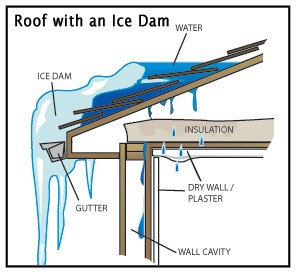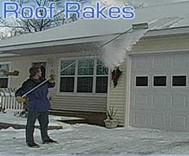The winter season means we need to be aware of ice dams. So what exactly is an ice dam? An ice dam occurs when snow accumulates on a roof and a cycle of melting and refreezing occurs. Two factors, besides snow, significantly contribute to the formation of ice dams: the outside air temperature and the temperature of the inside of your attic.

Warm attics will promote melting of snow on the roof. Under normal circumstances the resulting water would simply flow off the edge of the roof. But when outside air temperatures are very cold, the edge of the roof stays below freezing causing the water to refreeze at the edge. The ice forms a line or “dam” at the edge of the roof. As more snow continues to melt, it continues to re-freeze when it reaches the “ice dam” causing the dam to get bigger.
Water damage occurs when the dam gets so large that the melted snow that pools up behind the dam forces its way back under the roof shingles, ultimately leaking into your home. A good ice shield barrier will help prevent water intrusion, however, some dams will form higher on a roof. This will allow water to get past the ice shield. Nail penetrations in the ice shield can also allow water to enter a well-shielded roof. Gutters do not cause ice dams, but ice dams can extend to the gutters. We have all seen pretty icicles forming on roof lines. This is not something you want to see on your home!
How can ice dams be prevented?
Keeping snow off the roof is probably the most effective solution, however, this is not always easy, practical or convenient.

(To avoid the formation of ice dams keep heavy snowfall off the roof by investing in a roof rake)
If you expect to have snow on your roof the following may be helpful:
- In most cases, ice dams can be prevented by proper insulation and ventilation. Because a main cause of ice dams is an overly warm attic, it’s advisable to keep your attic as cold as possible. A well-designed attic will have good air exchange with the outside air and is physically and thermally isolated from the living space below. Make sure your ventilation system is properly sized and unobstructed. Additionally, ensure that your attic is properly insulated. Seal all penetrations that will allow air to flow into the attic from the living spaces. This can include attic doors and hatches, any exhaust (bathroom fans, whole house fans, etc),and any other ceiling penetrations such as recessed lighting.
- Take notice of sections of the roof with accelerated snowmelt. This can be an indication of excessive heat getting into the attic. You may see this associated with an uninsulated attic entry hatch. Improved insulation under this area may correct this situation, but a thorough inspection of the attic would be recommended.
- Penetrations that have been sealed in the past still need to be inspected to ensure that any weather stripping and/or insulation is intact and functioning properly, such as on attic stairways or hatchways.
- If your attic ventilation system does not generate sufficient air movement to dissipate the heat, you can improve ventilation with a motorized vent. Inspect your attic to be certain that existing vents are functioning properly.
- Typical ventilation for venting is 1 square foot for every 150 feet of attic floor area. If your home does not have this ratio, consult with a contractor to make the necessary adjustment.
